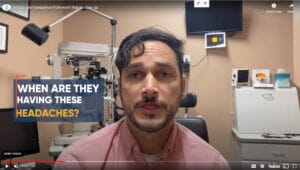Identifying the Cause of Your Headaches
When a patient presents with a chief complaint of headaches, we will take the time to understand when and under what circumstances the headaches occur. By asking questions and gathering information about the patient's daily activities and headache patterns, we aim to determine the root cause of the headaches.
If the headaches seem to happen randomly and in various situations, it may not be a result of an eye problem. However, if the headaches persist specifically when the patient engages in close work, such as reading, using the computer, or other detailed tasks, it is more likely to be an eye problem. The increased demand on the eyes during these tasks, as compared to activities such as gym class or sleeping, may be causing the headaches.
When a patient experiences headaches specifically during close work, such as reading or using a computer, it is possible that they are suffering from an underlying eye condition. Some common eye conditions that can cause headaches include:
Eye strain: Prolonged use of electronic devices or extended periods of close work can cause eye strain, leading to headaches.
Binocular Vision Dysfunction: When the eyes have trouble working together, they may become strained and overworked, leading to high levels of ocular stress and resulting in physical pain. Some examples of binocular vision problems include eye misalignment and convergence insufficiency.
Refractive Errors: Refractive errors, such as nearsightedness, farsightedness, and astigmatism, can cause the eyes to work harder to focus, leading to eye strain and headaches.
Presbyopia: As we age, the lens in our eyes loses its ability to adjust to different focus distances, causing headaches and eye strain when reading or doing close work.
Dry eyes: Dry eyes can cause eye irritation and discomfort, leading to headaches.
By identifying the specific eye condition causing the headaches, we can provide an effective treatment plan to alleviate the symptoms and improve the patient's overall eye health.













